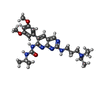Entry Database : PDB / ID : 5a4cTitle FGFR1 ligand complex FIBROBLAST GROWTH FACTOR RECEPTOR 1 (FMS-RELATED TYROSINE KINASE 2, PFEIFFER SYNDROME), ISOFORM CRA_B Keywords / Function / homology Function Domain/homology Component
/ / / / / / / / / / / / / / / / / / / / / / / / / / / / / / / / / / / / / / / / / / / / / / / / / / / / / / / / / / / / / / / / / / / / / / / / / / / / / / / / / / / / / / / / / / / / / / / / / / / / / / / / / / / / / / / / / / / / / / / / / / / / / / / / / / / / / / / / / / / / / / / / / / / / / / Biological species HOMO SAPIENS (human)Method / / / Resolution : 2.09 Å Authors Klein, T. / Vajpai, N. / Phillips, J.J. / Davies, G. / Holdgate, G.A. / Phillips, C. / Tucker, J.A. / Norman, R.A. / Scott, A.S. / Higazi, D.R. ...Klein, T. / Vajpai, N. / Phillips, J.J. / Davies, G. / Holdgate, G.A. / Phillips, C. / Tucker, J.A. / Norman, R.A. / Scott, A.S. / Higazi, D.R. / Lowe, D. / Thompson, G.S. / Breeze, A.L. Journal : Nat.Commun. / Year : 2015Title : Structural and Dynamic Insights Into the Energetics of Activation Loop Rearrangement in Fgfr1 Kinase.Authors : Klein, T. / Vajpai, N. / Phillips, J.J. / Davies, G. / Holdgate, G.A. / Phillips, C. / Tucker, J.A. / Norman, R.A. / Scott, A.D. / Higazi, D.R. / Lowe, D. / Thompson, G.S. / Breeze, A.L. History Deposition Jun 5, 2015 Deposition site / Processing site Revision 1.0 Aug 5, 2015 Provider / Type Revision 1.1 May 8, 2024 Group Data collection / Database references ... Data collection / Database references / Derived calculations / Other Category chem_comp_atom / chem_comp_bond ... chem_comp_atom / chem_comp_bond / database_2 / pdbx_database_status / struct_site Item _database_2.pdbx_DOI / _database_2.pdbx_database_accession ... _database_2.pdbx_DOI / _database_2.pdbx_database_accession / _pdbx_database_status.status_code_sf / _struct_site.pdbx_auth_asym_id / _struct_site.pdbx_auth_comp_id / _struct_site.pdbx_auth_seq_id
Show all Show less
 Open data
Open data Basic information
Basic information Components
Components Keywords
Keywords Function and homology information
Function and homology information HOMO SAPIENS (human)
HOMO SAPIENS (human) X-RAY DIFFRACTION /
X-RAY DIFFRACTION /  SYNCHROTRON /
SYNCHROTRON /  MOLECULAR REPLACEMENT / Resolution: 2.09 Å
MOLECULAR REPLACEMENT / Resolution: 2.09 Å  Authors
Authors Citation
Citation Journal: Nat.Commun. / Year: 2015
Journal: Nat.Commun. / Year: 2015 Structure visualization
Structure visualization Molmil
Molmil Jmol/JSmol
Jmol/JSmol Downloads & links
Downloads & links Download
Download 5a4c.cif.gz
5a4c.cif.gz PDBx/mmCIF format
PDBx/mmCIF format pdb5a4c.ent.gz
pdb5a4c.ent.gz PDB format
PDB format 5a4c.json.gz
5a4c.json.gz PDBx/mmJSON format
PDBx/mmJSON format Other downloads
Other downloads 5a4c_validation.pdf.gz
5a4c_validation.pdf.gz wwPDB validaton report
wwPDB validaton report 5a4c_full_validation.pdf.gz
5a4c_full_validation.pdf.gz 5a4c_validation.xml.gz
5a4c_validation.xml.gz 5a4c_validation.cif.gz
5a4c_validation.cif.gz https://data.pdbj.org/pub/pdb/validation_reports/a4/5a4c
https://data.pdbj.org/pub/pdb/validation_reports/a4/5a4c ftp://data.pdbj.org/pub/pdb/validation_reports/a4/5a4c
ftp://data.pdbj.org/pub/pdb/validation_reports/a4/5a4c Links
Links Assembly
Assembly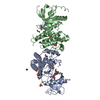

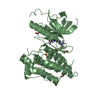
 Components
Components HOMO SAPIENS (human) / Production host:
HOMO SAPIENS (human) / Production host: 
 X-RAY DIFFRACTION / Number of used crystals: 1
X-RAY DIFFRACTION / Number of used crystals: 1  Sample preparation
Sample preparation SYNCHROTRON / Site:
SYNCHROTRON / Site:  Diamond
Diamond  / Beamline: I04 / Wavelength: 1.54
/ Beamline: I04 / Wavelength: 1.54  Processing
Processing MOLECULAR REPLACEMENT / Resolution: 2.09→28.73 Å / Cor.coef. Fo:Fc: 0.9508 / Cor.coef. Fo:Fc free: 0.9298 / SU R Cruickshank DPI: 0.192 / Cross valid method: THROUGHOUT / σ(F): 0 / SU R Blow DPI: 0.196 / SU Rfree Blow DPI: 0.17 / SU Rfree Cruickshank DPI: 0.169
MOLECULAR REPLACEMENT / Resolution: 2.09→28.73 Å / Cor.coef. Fo:Fc: 0.9508 / Cor.coef. Fo:Fc free: 0.9298 / SU R Cruickshank DPI: 0.192 / Cross valid method: THROUGHOUT / σ(F): 0 / SU R Blow DPI: 0.196 / SU Rfree Blow DPI: 0.17 / SU Rfree Cruickshank DPI: 0.169  Movie
Movie Controller
Controller



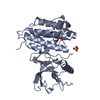
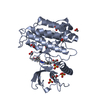
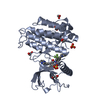
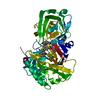
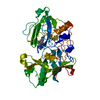
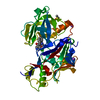

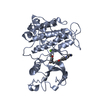
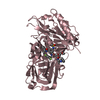
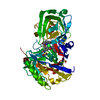

 PDBj
PDBj














